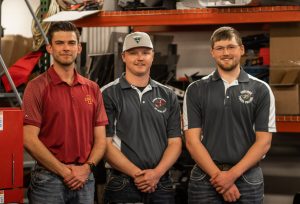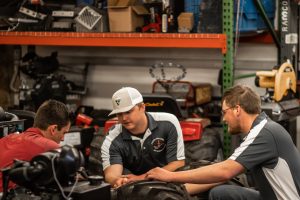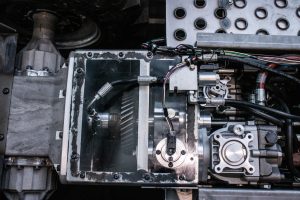ABE Students Build a CVT Transmission Using Mathematical Models for Capstone Project
Author: Sarah Hays
Author: Sarah Hays

Every year, the Department of Agricultural and Biosystems Engineering welcomes innovative and new projects from seniors in the department, known as capstone projects, bringing their new ideas and education to a client in the industry. This year, seniors Dean Woodwell, Collin Jones and Colin Kyhl built their capstone project for the Cyclone Power Pullers, an engineering club on campus designing a tractor for the ASABE International Quarter Scale Competition.
All three seniors are a part of the Cyclone Power Pullers. Every summer, the club brings a tractor to a competition to compete for the best maneuverability, durability and ability to pull large loads. The tractor has a set engine and tires that the members are not allowed to modify, but the rest is up to the team to design and build.
Woodwell, Jones and Kyhl had the perfect plan to give their capstone project back to Iowa State, designing and building a transmission for the club’s tractor. The team prides themselves on innovation, always implementing or improving on new powertrain concepts year to year.

As the team started looking into how they could improve on last year’s transmission, they noted that the main improvement they wanted to implement was better operator control of the transmission, pushing toward the Continuously Variable Transmission (CVT) route. From that, they created a hydromechanical power split transmission in an output coupled configuration.
“We always try to be pretty innovative in our transmission concept,” Woodwell said. “That was kind of the whole basis of what we brought into the capstone project here – the initial brainstorming, design, manufacturing and control of a transmission that we will be bringing to the competition this year.”
Last year, the team created a power shift transmission with fixed gear ratios, and operators were required to shift between gears during operation. This year, the three seniors wanted to make the tractor more accessible to all with a CVT Transmission.
From beginning to end, the team designed, managed, and built the transmission. From the very first day of the project, conceptually designing the transmission through simulated models, to testing the physical transmission, the team spent many hours bringing their capstone project to life.

“We initially designed the transmission in September, and then we would send parts out later on in the fall or early winter,” Woodwell said. “And after receiving parts during the winter months, in April we finally tested the transmission.”
Because of the team’s meticulous calculations in the fall, by the time they assembled the transmission and tested it, the transmission control system was operational shortly after beginning testing. This was the first time the team used a simulation model – a way to model the transmission’s performance and control system before actually assembling the device. The simulation model was made in MATLAB Simulink with continuous mathematical equations to test the system’s performance and efficiency.
Every week, the team has put in hours not only during their two hour capstone class, but they also put in work outside of class, in between classes and on the weekends. One of their biggest takeaways from the capstone project is how to effectively manage time, they said.
“Between balancing work, class and our project, it can become a pretty significant undertaking, so it was really important to manage your time wisely,” Kyhl said. “Being able to account for long lead time on parts was something important to learn, too.”

With the competition taking place in June, and their presentations conducted in April, the team has successfully designed a CVT Transmission for the tractor in less than a year. The takeaway from this project that they can bring to their future careers is highly impactful, the team’s advisor, Stuart Birrell said.
“The real strength of the whole project is that in the length of one year, they are doing a full project development cycle,” Birrell said. “From doing the design, the simulation, the development and testing of prototypes. So in essence, they are essentially operating as a design team in a company while learning valuable skills like decision making.”
After graduation this May, all three seniors have engineering positions at Danfoss, Vermeer and Kinze. And with the problem solving and decision-making skills they gained from this capstone project, they will have the ability to make quick and educated decisions and solve problems in their future careers as engineers.